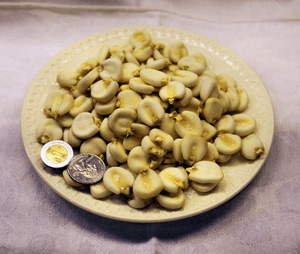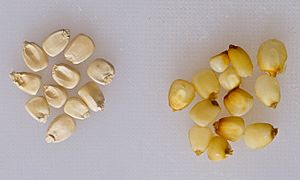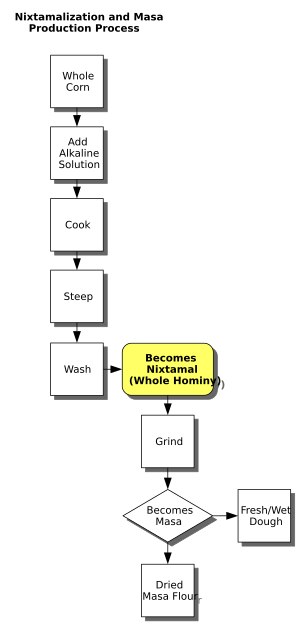Nixtamalization facts for kids
Nixtamalization is a special way to prepare maize (corn) or other grains. It involves soaking and cooking the corn in an alkaline (basic) solution, usually limewater. After cooking, the corn is washed and its outer skin (hull) is removed. This process is amazing because it can remove almost all harmful substances called aflatoxins from corn that might be contaminated.
Nixtamalized corn is much better than plain corn. It's easier to grind into flour, it has more nutrients, and it tastes and smells better. The alkaline solution helps break down the corn's cell walls, making the hulls easy to remove and softening the kernels. It also changes a type of niacin (a form of vitamin B3) in corn, making it available for your body to use. This helps prevent a disease called pellagra.
This process also helps corn proteins stick together better, allowing the corn to form a dough (called masa) when water is added. Without nixtamalization, corn flour alone can't make a dough. Because of these benefits, nixtamalization is a very important first step for making many corn-based foods like tortillas, tortilla chips, tamales, and hominy.
Contents
Where Did the Word Nixtamalization Come From?
The word "nixtamalization" comes from the Aztec language, Nahuatl. The Aztec word for the corn product made by this process is nixtamalli or nextamalli. This word then became nixtamal in Mexican Spanish.
The Nahuatl word is a mix of two words: nextli, meaning "ashes," and tamalli, meaning "unformed corn dough" or "tamal." While "nixtamalization" can describe removing the outer skin from any grain using an alkaline process, when you see it in English, it almost always refers to corn.
When you buy tortillas made with nixtamalized corn, the ingredients list might say "corn treated with lime" in English. In Spanish, it will say maíz nixtamalizado.
The History of Nixtamalization
How Nixtamalization Started in Mesoamerica

The nixtamalization process was first developed in Mesoamerica, which is the region where corn originally came from. We don't know the exact date it was invented, but the oldest signs of nixtamalization tools are from Guatemala's southern coast, dating back to 1200–1500 BCE. That's a very long time ago!
No one knows exactly how nixtamalization was discovered. One idea is that early cultures might have used hot stones to boil corn because they didn't have cooking pots strong enough for direct fire. In places with lots of limestone, like Guatemala and southern Mexico, people might have used heated chunks of limestone. Experiments show that hot limestone makes the cooking water alkaline enough for nixtamalization to happen naturally.
Ancient civilizations like the Aztecs and Mayans used slaked lime (calcium hydroxide) and ash (potassium hydroxide) to create the alkaline solutions. Other groups in North America used natural sodium carbonate or ash.
This process was super important for the early Mesoamerican diet. Most of the niacin in raw corn is "locked up" and can't be used by the body. People who ate a lot of untreated corn often got sick with diseases like pellagra, which is a niacin deficiency. But corn cooked with lime or other alkaline solutions provided usable niacin. Also, eating beans with corn provided other important nutrients that corn was missing, making it a more complete meal.
As corn farming spread across the Americas, so did nixtamalization. Traditional foods in places like Mexico and Central America still use nixtamalized corn today.
Even though it's still widely used in Mesoamerica, nixtamalization has become less common in North America. Many Native American tribes, like the Huron, no longer use it. However, some traditional communities still prepare nixtamalized corn using old techniques. For example, the Hopi people use ashes from different plants and trees for their alkali. Some modern Maya people use ashes from burnt mussel shells or cook corn with small pieces of limestone.
When European settlers came to the United States, they didn't always adopt nixtamalization, except for making hominy grits. Corn became a main food for poor people in the southern states, and because they didn't nixtamalize it, many suffered from pellagra in the early 1900s. Luckily, eating a wider variety of foods and adding vitamins to wheat flour has mostly stopped this problem.

Nixtamalization in Europe, Africa, and India
Christopher Columbus brought corn to Europe in the 1400s. It quickly spread through Europe, and then to Africa and India because it grew so well. By the 1500s, Portuguese colonists were growing corn in Africa, where it became a major food crop.
However, the nixtamalization process didn't travel with the corn to Europe, Africa, and India. This might be because Europeans already had machines to remove the outer skins of grains. Without alkaline processing, corn is not as healthy. This led to many people suffering from malnutrition. In the 1800s, there were pellagra outbreaks in France, Italy, and Egypt. A disease called kwashiorkor also affected parts of Africa where corn became a main food.
Today, health problems from corn-based diets are usually fixed with vitamin supplements and better diets, rather than by adopting nixtamalization. While pellagra has disappeared from Europe and the United States, it's still a big health issue in parts of Egypt, South Africa, and India.
How Nixtamalization Works
The nixtamalization process has a few key steps:
- Cooking: First, dried corn kernels are cooked in an alkaline solution, usually at a high temperature, close to boiling.
- Soaking: After cooking, the corn is left to soak in the cooking liquid for a while. The cooking and soaking times can vary a lot, from a few minutes to a whole day, depending on local traditions and what food is being made.
During this cooking and soaking, many changes happen to the corn kernels:
- The outer skin (pericarp or hull) loosens and softens.
- The corn kernels absorb water and minerals like calcium or potassium from the solution.
- The starches inside the corn swell up and become gel-like.
- Certain chemicals are released from the corn's germ, making the cooked kernels easier to grind. These chemicals also help the dough made from the corn be stronger and less likely to tear.
- The cooking process also changes the corn's proteins, making them and other nutrients easier for your body to absorb.
After the corn is cooked and soaked, the alkaline liquid (called nejayote) is poured away. This liquid contains dissolved hulls, starch, and other corn bits. The kernels are then washed very well to remove any remaining nejayote, which has an unpleasant taste. Finally, the outer skin (pericarp) is removed. This can be done by hand for small amounts or by machines in factories.
The prepared corn is called nixtamal. Nixtamal can be used in many ways, both fresh and dried for later use. Whole nixtamal is used in dishes like pozole and menudo. Freshly ground nixtamal is made into dough for tortillas, tamales, and arepas. If it's dried and ground, it's called masa harina or instant masa flour, which can be mixed with water to make dough.
The word hominy can refer to whole, coarsely ground, or finely ground nixtamal, or to a cooked porridge made from it.
Modern Enzymatic Nixtamalization
For large factories, a newer method called enzymatic nixtamalization has been developed. This process uses special enzymes called proteases to speed up the changes that happen in traditional nixtamalization. In this method, corn is partly soaked in hot water, then briefly soaked (about 30 minutes) in an alkaline solution with the enzymes.
This modern method uses less energy and water, creates less waste liquid (nejayote), and is much faster (about four hours) compared to traditional nixtamalization.
How Nixtamalization Helps Your Health
The main health benefits of nixtamalization come from the alkaline cooking process. This process changes the niacin in corn (called "niacytin") into a form that your body can easily absorb. This is very important because it helps prevent pellagra, a disease caused by not enough niacin. The alkaline process also slightly changes the corn's proteins, which helps balance the important amino acids your body needs.
Another benefit is that the corn can absorb minerals from the alkaline solution or from the cooking pots. This can greatly increase the amount of calcium (by up to 750%), iron, copper, and zinc in the corn.
Finally, nixtamalization significantly reduces (by 90–94%) harmful substances called mycotoxins. These toxins are produced by molds that often grow on corn and can be very bad for your health.
Images for kids
-
An 1836 lithograph showing tortilla production in rural Mexico.
See also
 In Spanish: Nixtamalización para niños
In Spanish: Nixtamalización para niños




